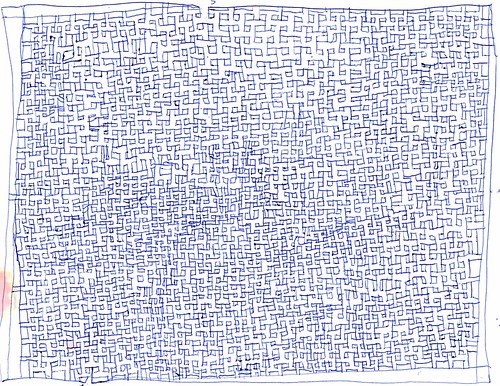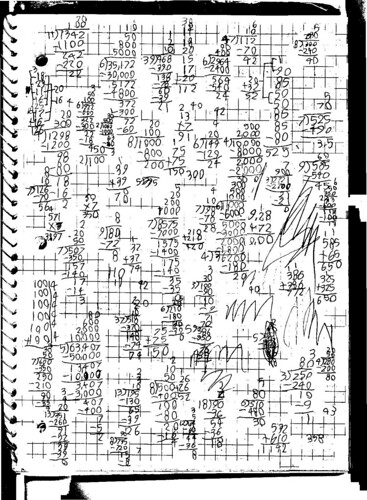I wrote a comment at Peter Gray’s “Psychology Today” in response to his blog post entitled, “When Less is More: The Case for Teaching Less Math in Schools.” I thought it would be useful if I shared the journey my son, Eli, took for learning and loving math.
Eli is pursing both a computer science and mathematics degree at 19 today. He showed from an early age that he would be gifted in the spatial arena. He viewed everything spatially, and math was no exception. In fact, I would have to surmise that those who are builder-types and view things spatially have a natural bent toward learning and loving mathematics. I believe his spatial skill development truly started through his play choices.
And continued into higher levels:
At around the same age of 1.5 years old, Eli also took notice of his big brother’s die cast Thomas the Tank Engine train collection. He would meticulously link them together and drive them around a large space in my kitchen. He liked to get right down at the same level of the trains, with his face pressed into the floor, as he drove them around. This showed early skill development of visualization of spatial concepts.
When Eli was almost 3 years old, he received his first Brio wooden train tracks for Christmas. Oh, was he excited! He began constructing train track configurations ever since, including any other style he found or was given. I remember well this little corner in our living room was put to good use as Eli’s train corner. Again, the visualization and spatial skills necessary to accomplish this is evident.
I don’t know when I bought the Lincoln Logs to have in the house. I think I may have done so when my two older children were younger, thinking it to be a classic toy, so I would bring that into the home. I may have also done it on my “all wooden toy” kick. Needless to say, when Eli discovered them, they were next on his agenda to conquer. One day, I was to get a big surprise when I walked into his room. I found that he had taken the Lincoln Log pieces and laid them out to represent all the single digit numbers. He was about age 4.5 years. I guess that would have been my first indication that he would naturally be drawn to math! He would subsequently build with Lincoln Logs traditionally.
It was between the ages of 4-5 years old that Eli started dabbling in areas recognized as math by society, though often not valued as much as it should be, especially in the early years for a right-brained builder type. From 5-7, Eli discovered manipulative-based logic math experiences through pentominoes, tangrams, geoboards, pattern blocks, etc. He would spend hours challenging himself through books and visual diagrams related to these resources.
Because he showed such a fascination from these types of resources, I could see that math intrigued him, so I started introducing both arithmetic as well as other spatial-oriented activities. It was between 5-6 years old that I shared dot-to-dots with him, which he enjoyed. I also went on-line and printed off some mazes that I thought he would like. Further, at that same timeframe, I shared and gave access to how tracing paper works. As I looked in his 6-year-old folder, I noticed he would trace the mazes I gave him. This certainly sparked ideas in his mind! Here are two samples of his original progression with skill development through mazes:
 Eli’s hand-drawn original maze at 9 years old.
Eli’s hand-drawn original maze at 9 years old.
Also from 5-8, I exposed him to simple addition and subtraction. Although he is a strong right-brained learner, he also has a few left-brained traits, mainly organization and orderliness, that he gets from living with autism. With that in mind, as well as the idea that the “puzzle challenge” to math was forefront in how he viewed it, he seemed to take to it quite easily. As for reading, that was more traditionally along the right-brained timeframe of 8-10 years old.
Starting at 8 years old, Eli was ready to do more in-depth and even formal math, so I experimented with offering him the math series I had picked up through the recommendation of an admired unschooling friend. The series is called “Real Math” that was sponsored by the National Science Foundation. It highlights patterns in math and thinking skills through story problems and other strategies employed. It takes you through pre-algebra, but is no longer available it would appear upon trying to locate it through the internet searches. He continued with this series until 14 years old. Other math programs that I have tried that I think would be as advantageous would be Singapore and Math U See.
While doing this, I would share “math tricks” like doubling numbers and adding/subtracting one, or using 10, etc. He would get excited and created his own “Math Trick Book”, drawing out the concepts and creating his own “now you try it section”. Certainly, there were always opportunities that would arise that would show Eli how his amazing spatial skills are involved in real life. Here he is at a science museum putting together a cathedral:
Here are his first two resources for learning to computer program:




As outlined by my Collaborative Learning Process, I believe by honoring Eli’s natural progression toward math, through his creative outlets in the young years, and feeding this gift that revealed itself in the middle years, led to the explosion in computer programming that riddled his teen years and his subsequent choice to pursue it as a career. He also intends to minor in math.




























